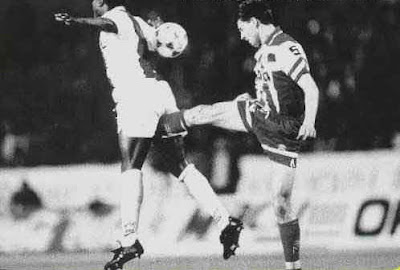Rules made in 1863
The Laws were first drawn up by Ebenezer Cobb Morley and approved at a meeting of the Football Association (FA) on 8 December 1863.
The
Football Association Laws of 1863 as published in the press (in Bell's Life) for approval on 5 December 1863:
The maximum length of the ground shall be 200 yards (180 m), the maximum breadth shall be 100 yards (91 m), the length and breadth shall be marked off with flags; and the goal shall be defined by two upright posts, eight yards (7 m) apart, without any tape or bar across them.
A toss for goals shall take place, and the game shall be commenced by a place kick from the centre of the ground by the side losing the toss for goals; the other side shall not approach within 10 yards (9.1 m) of the ball until it is kicked off.
After a goal is won, the losing side shall be entitled to kick off, and the two sides shall change goals after each goal is won.
A goal shall be won when the ball passes between the goal-posts or over the space between the goal-posts (at whatever height), not being thrown, knocked on, or carried.
When the ball is in touch, the first player who touches it shall throw it from the point on the boundary line where it left the ground in a direction at right angles with the boundary line, and the ball shall not be in play until it has touched the ground.
When a player has kicked the ball, any one of the same side who is nearer to the opponent's goal line is out of play, and may not touch the ball himself, nor in any way whatever prevent any other player from doing so, until he is in play; but no player is out of play when the ball is kicked off from behind the goal line.
In case the ball goes behind the goal line, if a player on the side to whom the goal belongs first touches the ball, one of his side shall be entitled to a free kick from the goal line at the point opposite the place where the ball shall be touched. If a player of the opposite side first touches the ball, one of his side shall be entitled to a free kick at the goal only from a point 15 yards (14 m) outside the goal line, opposite the place where the ball is touched, the opposing side standing within their goal line until he has had his kick.
If a player makes a fair catch, he shall be entitled to a free kick, providing he claims it by making a mark with his heel at once; and in order to take such kick he may go back as far as he pleases, and no player on the opposite side shall advance beyond his mark until he has kicked.
No player shall run with the ball.
Neither tripping nor hacking shall be allowed, and no player shall use his hands to hold or push his adversary.
A player shall not be allowed to throw the ball or pass it to another with his hands.
No player shall be allowed to take the ball from the ground with his hands under any pretence whatever while it is in play.
No player shall be allowed to wear projecting nails, iron plates, or gutta-percha[1] on the soles or heels of his boots.
At its meeting on 8 December the FA agreed (as reported in Bell's Life) John Lillywhite should publish the Laws, which he said he could do at a cost of a shilling for the pocket size and 1s 6d for the larger size for club rooms.
International Football Association Board
The Laws of the Game are written by the International Football Association Board (IFAB). They meet at least once a year to debate and decide any changes to the text as it exists at that time. The meeting in Winter generally leads to an update to the laws on 1 July of each year that take effect immediately. The laws govern all International matches and National matches of member organizations.
The board was established on December 6, 1882 when representatives from the Scottish Football Association (SFA), the Football Association of Wales (FAW) and the Irish Football Association (IFA) (now the governing body in Northern Ireland and not to be confused with the Football Association of Ireland (FAI) the governing body in the Republic of Ireland) were invited to attend a meeting in Manchester by the FA; previously games between teams from different countries had to agree to which country's rules were used before playing.
When the international football body on the continent FIFA was founded in Paris in 1904, it immediately declared that FIFA would adhere to the rules laid down by the IFAB. The growing popularity of the international game led to the admittance of FIFA representatives to the IFAB in 1913. Today the IFAB is made up of four representatives from FIFA representing their over 200+ member Nations and one representative each from the United Kingdom's four associations. Because six votes are required to make any changes to the Laws, no change can be made without FIFA's approval, but FIFA cannot change the Laws on its own.











